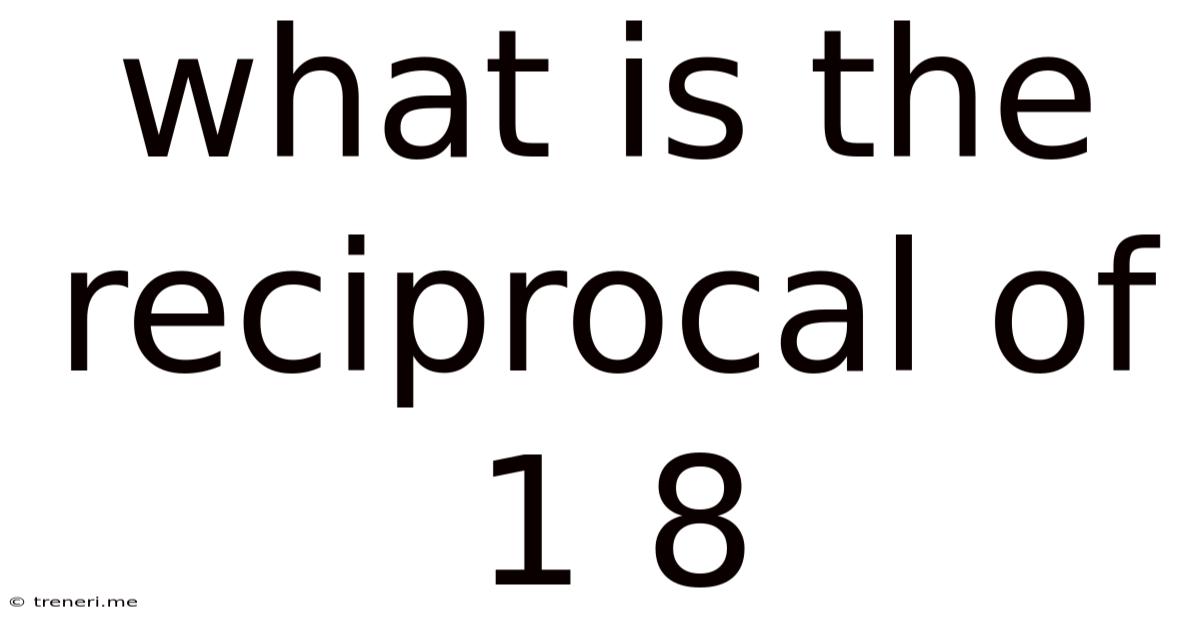What Is The Reciprocal Of 1 8
Treneri
May 11, 2025 · 4 min read

Table of Contents
What is the Reciprocal of 1/8? A Deep Dive into Reciprocals and Their Applications
The seemingly simple question, "What is the reciprocal of 1/8?" opens the door to a fascinating exploration of mathematical concepts with far-reaching applications. This article will not only answer that question directly but delve into the broader understanding of reciprocals, their properties, and their practical uses in various fields.
Understanding Reciprocals: The Multiplicative Inverse
A reciprocal, also known as a multiplicative inverse, is a number that, when multiplied by the original number, results in the multiplicative identity, which is 1. In simpler terms, it's the number you need to multiply a given number by to get 1.
For example:
- The reciprocal of 5 is 1/5 (because 5 * 1/5 = 1).
- The reciprocal of 2/3 is 3/2 (because 2/3 * 3/2 = 1).
- The reciprocal of 1 is 1 (because 1 * 1 = 1).
Important Note: Zero does not have a reciprocal because there is no number that, when multiplied by zero, equals 1. This is a fundamental concept in mathematics.
Finding the Reciprocal of 1/8
Now, let's address the initial question: What is the reciprocal of 1/8?
To find the reciprocal of a fraction, we simply flip the fraction – that is, we swap the numerator and the denominator.
Therefore, the reciprocal of 1/8 is 8/1, which simplifies to 8.
This is because (1/8) * 8 = 1.
Reciprocals in Different Number Systems
The concept of reciprocals extends beyond simple fractions. We can find reciprocals for:
1. Integers:
The reciprocal of any integer is simply 1 divided by that integer. For example:
- The reciprocal of 3 is 1/3.
- The reciprocal of -7 is -1/7.
2. Decimals:
To find the reciprocal of a decimal, convert it to a fraction, then find the reciprocal of the fraction. For example:
- The reciprocal of 0.5 (which is 1/2) is 2.
- The reciprocal of 0.25 (which is 1/4) is 4.
3. Negative Numbers:
The reciprocal of a negative number is also a negative number. The process remains the same: flip the fraction (or write 1 over the number). For instance, the reciprocal of -2/5 is -5/2.
Applications of Reciprocals
Reciprocals are not just abstract mathematical concepts; they are crucial tools in many areas:
1. Division:
Dividing by a number is the same as multiplying by its reciprocal. This is a fundamental property used extensively in algebra and calculus. For example, instead of dividing 10 by 2, we can multiply 10 by the reciprocal of 2 (which is 1/2), resulting in 5.
2. Solving Equations:
Reciprocals are essential when solving equations involving fractions. To isolate a variable multiplied by a fraction, we multiply both sides of the equation by the reciprocal of that fraction.
For example, in the equation (1/3)x = 5, we multiply both sides by 3 to find x: 3 * (1/3)x = 5 * 3, which simplifies to x = 15.
3. Physics and Engineering:
Reciprocals appear frequently in various physics formulas and engineering calculations, often representing inverse relationships between quantities. For instance, the reciprocal of resistance is conductance in electrical circuits.
4. Finance and Economics:
Reciprocals are involved in calculating rates of return, discounting factors, and other financial metrics. Understanding reciprocals is fundamental for financial modeling and analysis.
5. Computer Science:
In computer graphics and image processing, reciprocals are used in transformations and calculations involving matrices and vectors.
6. Chemistry:
Reciprocals are used in various chemical calculations, including molarity, concentration, and reaction rates.
Beyond the Basics: Exploring Related Concepts
Understanding reciprocals unlocks a deeper appreciation for several related mathematical ideas:
1. Inverse Functions:
Reciprocals are a specific example of inverse functions. An inverse function "undoes" the action of the original function. For example, the reciprocal function is the inverse of the function f(x) = 1/x.
2. Matrix Inversion:
In linear algebra, the concept of the reciprocal extends to matrices. The inverse of a matrix (when it exists) is a matrix that, when multiplied by the original matrix, results in the identity matrix (a matrix with 1s on the diagonal and 0s elsewhere). Matrix inversion is crucial for solving systems of linear equations and many other applications.
Practical Exercises and Further Exploration
To solidify your understanding of reciprocals, try the following exercises:
- Find the reciprocal of the following numbers: 2/7, -3, 0.75, 1.2
- Solve the equation (2/5)y = 10 using reciprocals.
- Research the applications of reciprocals in a field that interests you (e.g., optics, music theory, or game development).
By exploring these exercises and expanding your research, you'll gain a deeper understanding of the power and versatility of reciprocals in mathematics and beyond. The seemingly simple concept of the reciprocal of 1/8 ultimately reveals itself to be a keystone in many complex calculations and systems. It's a testament to the interconnected nature of mathematical concepts and their pervasive influence in the world around us. So, while the answer to the original question is straightforward, the journey to understand its implications is profound and rewarding.
Latest Posts
Latest Posts
-
1986 Was How Many Years Ago
May 12, 2025
-
What Is 5 To The Sixth Power
May 12, 2025
-
How Many Calories Burned 5k Run
May 12, 2025
-
What Is 60 Percent Of 200
May 12, 2025
-
How Many Decades In A Century
May 12, 2025
Related Post
Thank you for visiting our website which covers about What Is The Reciprocal Of 1 8 . We hope the information provided has been useful to you. Feel free to contact us if you have any questions or need further assistance. See you next time and don't miss to bookmark.